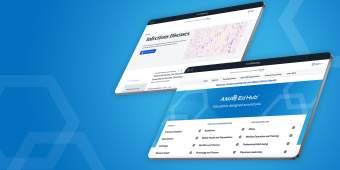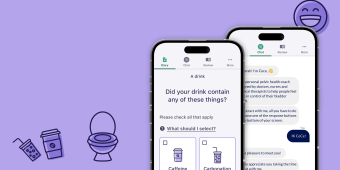How to shape and develop ideas to create value

Clients come to us not just to build software but also to help them understand what software to build––and whether they need to build software in the first place. In cases where we determine that a client does need new software, our first job is to determine what they (and therefore their users) need.
Our goal is to create something new that becomes widely adopted by our client’s end-users and creates significant value––both social and economic. In this piece, I’ll explain how we do that by breaking that goal into three parts: creating something new, ensuring wide adoption and creating significant value.
Creating something new by generating lots of ideas
To create new things, we have to question the status quo. To consistently create new things, it’s best to get into the habit of questioning the status quo whenever possible––not just during working hours.
This means asking questions like, “Why are things like this?” and “Why can’t I do this?” and “What would happen if I did this other thing?” In other words, we get into the habit of brainstorming at every hour of the day.
Not all of our questions lead to good ideas. In fact, most of them will lead to bad ideas; as we’ve discussed in the past, those are part of the plan.
One frequently cited example of this: the famously innovative Dyson vacuum came to be after more than 5,000 prototypes.
The takeaway in a custom software development context is this: no solution starts off perfect. To consistently create value, we take imperfect ideas and shape and develop them until they work.
Getting wide adoption by seeking ongoing feedback
For our clients, a product isn’t a success if users don’t adopt it. So how do we ensure that the things we build enjoy high user adoption? We seek feedback.
For that feedback to effectively shape our ideas and ultimately lead to user adoption, we have to do three things:
- Proactively seek it out: We seek feedback at every stage of our process. We share rough ideas and sketches with colleagues. We conduct both formal and informal user research. We share ideas and models with clients and get their input.
- Gather feedback continuously: Our goal is not to create a perfect solution on the first try (remember: no solution starts perfect). Rather, we aim to identify questions and concerns we have as early as possible, identify which ones are riskiest and test those––over and over again.
- Make changes based on the feedback: As our tests yield feedback, we adjust based on that feedback. And then we test again.
The premise here is pretty straightforward, but actually making this work requires skill and experience. To ensure we’re gathering feedback that will lead to a product that creates real value for users and therefore widespread user adoption, we have to make sure we’re gathering valid feedback.
We have to be sure we don’t, for example, fall in love with a prototype and design tests that ensure the idea succeeds.
What’s more, we have to make sure the thing we’re testing is an accurate representation of a thing we’d eventually build––but that doesn’t take too much time or energy to create. This means creating a sketch or wireframe or prototype that is lean and tight and a test that yields clean data in a relatively short time.
Creating significant value by iterating based on feedback
The goal of all our testing and feedback gathering is to learn. With the learnings we gather, we improve the product incrementally. The products we create often incorporate hundreds of ideas from every stage of our process.
It’s a bit like making a long-simmering soup. An experienced cook doesn’t just throw a bunch of ingredients in the pot, let it cook for six hours and hope for the best. They taste at every phase, adjust seasonings and make changes to create a pleasing, balanced soup.
There are no big surprises––good or bad––at the end.
That’s not how many organizations approach product development. Often, companies operate with an “all or nothing” model. They aim for perfection and completion and don’t see value in the process of testing.
Products launched in that way often fail, though. They don’t offer real value. They don’t improve users’ lives because they didn’t take users’ lives into account from the start. They amount to a large waste of time and money. Which brings me to my next (and last) point.
Consistent innovation requires cultural transformation
Many of today’s most successful brands are ones that are constantly creating new value because they’re constantly generating and testing new ideas, shaping them based on feedback and launching new products based on what they learn. For example:
- Starbucks started as a seller of beans. Today, it sells wine and cheese plates.
- Amazon started as an online bookseller. Today, it offers cloud hosting services and just about everything else.
- YouTube started as an online dating site. Today, it’s a learning platform, a home for interactive gaming and much more.
But innovation isn’t something that only matters for behemoths. Brands of any size in any industry that want to stay ahead of their competition must adopt a culture of innovation moving forward. That’s the only way to remain viable in a constantly changing world.
But cultural transformation is hard, no matter what kind of transformation you're trying to implement. And this, as much as in conceptualizing and delivering a specific software solution, is where TXI can add real value.
By collaborating with your team, our teams model the culture of innovation that’s necessary for ongoing growth and adaptability. We show you how to operate to gain and maintain a competitive edge. By working with us, your team can learn how to work differently, in a way that consistently drives innovation.
Bring a culture of innovation to your organization
Having good ideas, shaping those ideas and creating new value for your organization are all learnable practices.
If you’d like to hear more about how working with TXI can help you not only discover and launch a solution to meet an immediate need your organization has but also equip you with the skills you need to consistently solve future problems, get in touch. We’d love to share more about our process and approach.
Published by Antonio Garcia in Product Innovation

Let's shape your insights into experience-led data products together.


